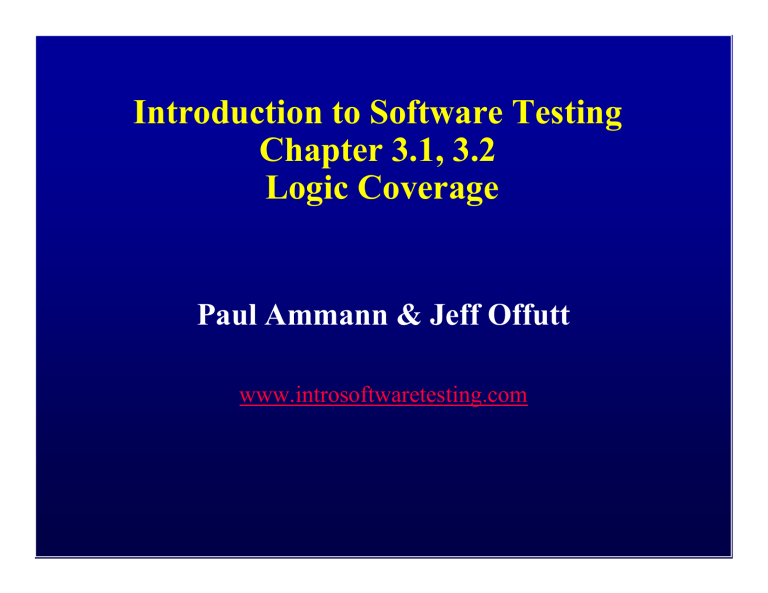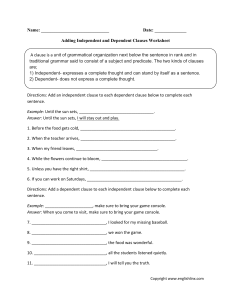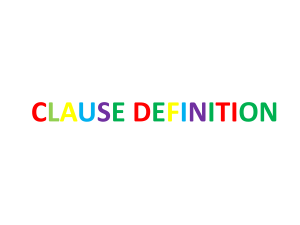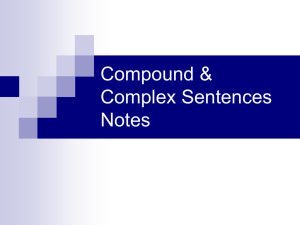
Introduction to Software Testing Chapter 3.1, 3.2 Logic Coverage Paul Ammann & Jeff Offutt www.introsoftwaretesting.com Ch. 3 : Logic Coverage Four Structures for Modeling Software Graphs Logic Input Space Syntax Applied to Applied to Source Specs Source Specs Design Applied to FSMs DNF Source Integ Use cases Introduction to Software Testing (Ch 3), www.introsoftwaretesting.com Models © Ammann & Offutt Input 2 Covering Logic Expressions (3.1) • Logic expressions show up in many situations • Covering logic expressions is required by the US Federal Aviation Administration for safety critical software • Logical expressions can come from many sources – Decisions in programs – FSMs and statecharts – Requirements • Tests are intended to choose some subset of the total number of truth assignments to the expressions Introduction to Software Testing (Ch 3), www.introsoftwaretesting.com © Ammann & Offutt 3 Logic Predicates and Clauses • A predicate is an expression that evaluates to a boolean value • Predicates can contain – boolean variables – non-boolean variables that contain >, <, ==, >=, <=, != – boolean function calls • Internal structure is created by logical operators – ¬ – the negation operator – ∧ – the and operator – ∨ – the or operator – → – the implication operator – ⊕ – the exclusive or operator – ↔ – the equivalence operator • A clause is a predicate with no logical operators Introduction to Software Testing (Ch 3), www.introsoftwaretesting.com © Ammann & Offutt 4 Examples • (a < b) ∨ f (z) ∧ D ∧ (m >= n*o) • Four clauses: – (a < b) – relational expression – f (z) – boolean-valued function – D – boolean variable – (m >= n*o) – relational expression • Most predicates have few clauses – It would be nice to quantify that claim! • Sources of predicates – Decisions in programs – Guards in finite state machines – Decisions in UML activity graphs – Requirements, both formal and informal – SQL queries Introduction to Software Testing (Ch 3), www.introsoftwaretesting.com © Ammann & Offutt 5 Translating from English • “I am interested in SWE 637 and CS 652” • course = swe637 OR course = cs652 Humans have trouble translating from English to Logic • “If you leave before 6:30 AM, take Braddock to 495, if you leave after 7:00 AM, take Prosperity to 50, then 50 to 495” • time < 6:30 → path = Braddock ∨ time > 7:00 → path = Prosperity • Hmm … this is incomplete ! • time < 6:30 → path = Braddock ∨ time >= 6:30 → path = Prosperity Introduction to Software Testing (Ch 3), www.introsoftwaretesting.com © Ammann & Offutt 6 Testing and Covering Predicates (3.2) • We use predicates in testing as follows : – Developing a model of the software as one or more predicates – Requiring tests to satisfy some combination of clauses • Abbreviations: – P is the set of predicates – p is a single predicate in P – C is the set of clauses in P – Cp is the set of clauses in predicate p – c is a single clause in C Introduction to Software Testing (Ch 3), www.introsoftwaretesting.com © Ammann & Offutt 7 Predicate and Clause Coverage • The first (and simplest) two criteria require that each predicate and each clause be evaluated to both true and false Predicate Coverage (PC) : For each p in P, TR contains two requirements: p evaluates to true, and p evaluates to false. • When predicates come from conditions on edges, this is equivalent to edge coverage • PC does not evaluate all the clauses, so … Clause Coverage (CC) : For each c in C, TR contains two requirements: c evaluates to true, and c evaluates to false. Introduction to Software Testing (Ch 3), www.introsoftwaretesting.com © Ammann & Offutt 8 Predicate Coverage Example ((a < b) ∨ D) ∧ (m >= n*o) predicate coverage Predicate = true a = 5, b = 10, D = true, m = 1, n = 1, o = 1 = (5 < 10) ∨ true ∧ (1 >= 1*1) = true ∨ true ∧ TRUE = true Predicate = false a = 10, b = 5, D = false, m = 1, n = 1, o = 1 = (10 < 5) ∨ false ∧ (1 >= 1*1) = false ∨ false ∧ TRUE = false Introduction to Software Testing (Ch 3), www.introsoftwaretesting.com © Ammann & Offutt 9 Clause Coverage Example ((a < b) ∨ D) ∧ (m >= n*o) Clause coverage (a < b) = true (a < b) = false D = true D = false a = 5, b = 10 D = true a = 10, b = 5 m >= n*o = true D = false m >= n*o = false m = 1, n = 1, o = 1 m = 1, n = 2, o = 2 false cases Two tests true cases 1) a = 5, b = 10, D = true, m = 1, n = 1, o = 1 2) a = 10, b = 5, D = false, m = 1, n = 2, o = 2 Introduction to Software Testing (Ch 3), www.introsoftwaretesting.com © Ammann & Offutt 10 Problems with PC and CC • PC does not fully exercise all the clauses, especially in the presence of short circuit evaluation • CC does not always ensure PC – That is, we can satisfy CC without causing the predicate to be both true and false – This is definitely not what we want ! • The simplest solution is to test all combinations … Introduction to Software Testing (Ch 3), www.introsoftwaretesting.com © Ammann & Offutt 11 Combinatorial Coverage • CoC requires every possible combination • Sometimes called Multiple Condition Coverage Combinatorial Coverage (CoC) : For each p in P, TR has test requirements for the clauses in Cp to evaluate to each possible combination of truth values. a<b D m >= n*o 1 T T T 2 T T F 3 T F T 4 T F F 5 F T T 6 F T F 7 F F T 8 F F F Introduction to Software Testing (Ch 3), www.introsoftwaretesting.com ((a < b) ∨ D) ∧ (m >= n*o) T F T F T F F F © Ammann & Offutt 12 Combinatorial Coverage • This is simple, neat, clean, and comprehensive … • But quite expensive! • 2N tests, where N is the number of clauses – Impractical for predicates with more than 3 or 4 clauses • The literature has lots of suggestions – some confusing • The general idea is simple: Test each clause independently from the other clauses • Getting the details right is hard • What exactly does “independently” mean ? • The book presents this idea as “making clauses active” … Introduction to Software Testing (Ch 3), www.introsoftwaretesting.com © Ammann & Offutt 13 Active Clauses • Clause coverage has a weakness : The values do not always make a difference • Consider the first test for clause coverage, which caused each clause to be true: – (5 < 10) ∨ true ∧ (1 >= 1*1) • Only the first clause counts ! • To really test the results of a clause, the clause should be the determining factor in the value of the predicate Determination : A clause c in predicate p, called the major i clause, determines p if and only if the values of the remaining minor clauses cj are such that changing ci changes the value of p • This is considered to make the clause active Introduction to Software Testing (Ch 3), www.introsoftwaretesting.com © Ammann & Offutt 14 Determining Predicates P=A∨ B P=A∧ B if B = true, p is always true. if B = false, p is always false. so if B = false, A determines p. so if B = true, A determines p. if A = false, B determines p. if A = true, B determines p. • Goal : Find tests for each clause when the clause determines the value of the predicate • This is formalized in several criteria that have subtle, but very important, differences Introduction to Software Testing (Ch 3), www.introsoftwaretesting.com © Ammann & Offutt 15 Active Clause Coverage Active Clause Coverage (ACC) : For each p in P and each major clause ci in Cp Cp,, choose minor clauses cj cj,, j != i, i, so that ci determines p. TR has two requirements for each ci : ci evaluates to true and ci evaluates to false. p=a∨b 1) a = true, b = false a is major clause 2) a = false, b = false b is major clause 3) a = false, b = true 4) a = false, b = false Duplicate • This is a form of MCDC, which is required by the FAA for safety critical software • Ambiguity : Do the minor clauses have to have the same values when the major clause is true and false? Introduction to Software Testing (Ch 3), www.introsoftwaretesting.com © Ammann & Offutt 16 Resolving the Ambiguity p = a ∨ (b ∧ c) Major clause : a a = true, b = false, c = true Is this allowed ? a = false, b = false, c = false • This question caused confusion among testers for years • Considering this carefully leads to three separate criteria : – Minor clauses do not need to be the same – Minor clauses do need to be the same – Minor clauses force the predicate to become both true and false Introduction to Software Testing (Ch 3), www.introsoftwaretesting.com © Ammann & Offutt 17 General Active Clause Coverage General Active Clause Coverage (GACC) : For each p in P and each major clause ci in Cp Cp,, choose minor clauses cj cj,, j != i, i, so that ci determines p. TR has two requirements for each ci : ci evaluates to true and ci evaluates to false. The values chosen for the minor clauses cj do not need to be the same when ci is true as when ci is false, that is, cj(ci = true) = cj(ci = false) for all cj OR cj(ci = true) != cj(ci = false) for all cj. cj. • This is complicated ! • It is possible to satisfy GACC without satisfying predicate coverage • We really want to cause predicates to be both true and false ! Introduction to Software Testing (Ch 3), www.introsoftwaretesting.com © Ammann & Offutt 18 Restricted Active Clause Coverage Restricted Active Clause Coverage (RACC) : For each p in P and each major clause ci in Cp Cp,, choose minor clauses cj cj,, j != i, i, so that ci determines p. TR has two requirements for each ci ci:: ci evaluates to true and ci evaluates to false. The values chosen for the minor clauses cj must be the same when ci is true as when ci is false, that is, it is required that cj(ci = true) = cj(ci = false) for all cj cj.. • This has been a common interpretation by aviation developers • RACC often leads to infeasible test requirements • There is no logical reason for such a restriction Introduction to Software Testing (Ch 3), www.introsoftwaretesting.com © Ammann & Offutt 19 Correlated Active Clause Coverage Correlated Active Clause Coverage (CACC) : For each p in P and each major clause ci in Cp Cp,, choose minor clauses cj cj,, j != i, i, so that ci determines p. TR has two requirements for each ci ci:: ci evaluates to true and ci evaluates to false. The values chosen for the minor clauses cj must cause p to be true for one value of the major clause ci and false for the other, that is, it is required that p(ci = true) != p(ci = false). false). • A more recent interpretation • Implicitly allows minor clauses to have different values • Explicitly satisfies (subsumes) predicate coverage Introduction to Software Testing (Ch 3), www.introsoftwaretesting.com © Ammann & Offutt 20 CACC and RACC 1 2 3 5 6 7 a a T T TT TT FF FF FF b c a ∧ (b ∨ c) T T T 1 T F T 5 F T T 2 T T F 6 T F F 3 a a T T F F T T F T F T F 7 F major clause CACC can be satisfied by choosing any of rows 1, 2, 3 AND any of rows 5, 6, 7 – a total of nine pairs Introduction to Software Testing (Ch 3), www.introsoftwaretesting.com b c a ∧ (b ∨ c) T T T T T F T F T T F F F T T F T F major clause RACC can only be satisfied by one of the three pairs above © Ammann & Offutt 21 Inactive Clause Coverage • The active clause coverage criteria ensure that “major” clauses do affect the predicates • Inactive clause coverage takes the opposite approach – major clauses do not affect the predicates Inactive Clause Coverage (ICC) : For each p in P and each major clause ci in Cp Cp,, choose minor clauses cj cj,, j != i, i, so that ci does not determine p. TR has four requirements for each ci ci:: (1) ci evaluates to true with p true, (2) ci evaluates to false with p true, (3) ci evaluates to true with p false, and (4) ci evaluates to false with p false. Introduction to Software Testing (Ch 3), www.introsoftwaretesting.com © Ammann & Offutt 22 General and Restricted ICC • Unlike ACC, the notion of correlation is not relevant – ci does not determine p, so cannot correlate with p • Predicate coverage is always guaranteed General Inactive Clause Coverage (GICC) : For each p in P and each major clause ci in Cp Cp,, choose minor clauses cj cj,, j != i, i, so that ci does not determine p. The values chosen for the minor clauses cj do not need to be the same when ci is true as when ci is false, that is, cj(ci = true) = cj(ci = false) for all cj OR cj(ci = true) != cj(ci = false) for all cj cj.. Restricted Inactive Clause Coverage (RICC) : For each p in P and each major clause ci in Cp Cp,, choose minor clauses cj cj,, j != i, i, so that ci does not determine p. The values chosen for the minor clauses cj must be the same when ci is true as when ci is false, that is, it is required that cj(ci = true) = cj(ci = false) for all cj cj.. Introduction to Software Testing (Ch 3), www.introsoftwaretesting.com © Ammann & Offutt 23 Logic Coverage Criteria Subsumption Combinatorial Clause Coverage COC Restricted Active Clause Coverage RACC Restricted Inactive Clause Coverage RICC Correlated Active Clause Coverage CACC General Inactive Clause Coverage GICC General Active Clause Coverage GACC Clause Coverage CC Introduction to Software Testing (Ch 3), www.introsoftwaretesting.com Predicate Coverage PC © Ammann & Offutt 24 Making Clauses Determine a Predicate • Finding values for minor clauses cj is easy for simple predicates • But how to find values for more complicated predicates ? • Definitional approach: – pc=true is predicate p with every occurrence of c replaced by true – pc=false is predicate p with every occurrence of c replaced by false • To find values for the minor clauses, connect pc=true and • pc=false with exclusive OR pc = pc=true ⊕ pc=false After solving, pc describes exactly the values needed for c to determine p Introduction to Software Testing (Ch 3), www.introsoftwaretesting.com © Ammann & Offutt 25 Examples p=a∨b pa = pa=true ⊕ pa=false = (true ∨ b) XOR (false ∨ b) = true XOR b =¬b p=a∧b pa = pa=true ⊕ pa=false = (true ∧ b) ⊕ (false ∧ b) = b ⊕ false =b p = a ∨ (b ∧ c) pa = pa=true ⊕ pa=false = (true ∨ (b ∧ c)) ⊕ (false ∨ (b ∧ c)) = true ⊕ (b ∧ c) = ¬ (b ∧ c) =¬ b∨¬c • “NOT b ∨ NOT c” means either b or c can be false • RACC requires the same choice for both values of a, CACC does not Introduction to Software Testing (Ch 3), www.introsoftwaretesting.com © Ammann & Offutt 26 Repeated Variables • The definitions in this chapter yield the same tests no matter how the predicate is expressed • (a ∨ b) ∧ (c ∨ b) == (a ∧ c) ∨ b • (a ∧ b) ∨ (b ∧ c) ∨ (a ∧ c) – Only has 8 possible tests, not 64 • Use the simplest form of the predicate, and ignore contradictory truth table assignments Introduction to Software Testing (Ch 3), www.introsoftwaretesting.com © Ammann & Offutt 27 A More Subtle Example p = ( a ∧ b ) ∨ ( a ∧ ¬ b) pa = pa=true ⊕ pa=false = ((true ∧ b) ∨ (true ∧ ¬ b)) ⊕ ((false ∧ b) ∨ (false ∧ ¬ b)) = (b ∨ ¬ b) ⊕ false = true ⊕ false = true p = ( a ∧ b ) ∨ ( a ∧ ¬ b) pb = pb=true ⊕ pb=false = ((a ∧ true) ∨ (a ∧ ¬ true)) ⊕ ((a ∧ false) ∨ (a ∧ ¬ false)) = (a ∨ false) ⊕ (false ∨ a) =a⊕a = false • a always determines the value of this predicate • b never determines the value – b is irrelevant ! Introduction to Software Testing (Ch 3), www.introsoftwaretesting.com © Ammann & Offutt 28 Infeasible Test Requirements • Consider the predicate: (a > b ∧ b > c) ∨ c > a • (a > b) = true, (b > c) = true, (c > a) = true is infeasible • As with graph-based criteria, infeasible test requirements have to be recognized and ignored • Recognizing infeasible test requirements is hard, and in general, undecidable • Software testing is inexact – engineering, not science Introduction to Software Testing (Ch 3), www.introsoftwaretesting.com © Ammann & Offutt 29 Logic Coverage Summary • Predicates are often very simple – PC may be enough – COC is practical • Control software often has many complicated predicates, with lots of clauses • Question … why don’t complexity metrics count the number of clauses in predicates? Introduction to Software Testing (Ch 3), www.introsoftwaretesting.com © Ammann & Offutt 30




